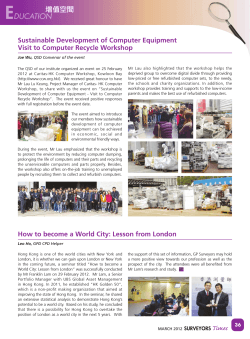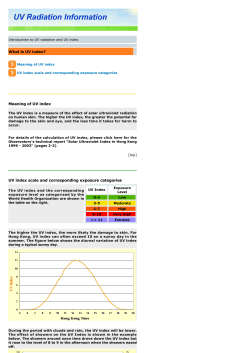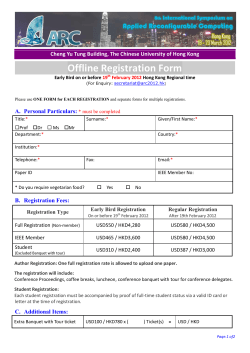
“Parental Responsibility” Why introduce the (Joint) Parental Responsibility Model ? 14 April 2012
“Parental Responsibility” Why introduce the (Joint) Parental Responsibility Model ? 14 April 2012 Dennis C. Ho Solicitors 1 Report on Child Custody and Access (“the Report”) “In other common law jurisdictions, there has been a shift away from this legal emphasis on the rights and authority of each of the parents over their children, towards a more child‐focused concept of "joint parental responsibility.“ This newer approach, which emphasizes the obligations rather than the rights of the parents, and stresses the rights 2 of the children to maintain a continuing relationship with both parents after divorce, is examined in this report as a possible model for Hong Kong's future legislation in this area.” (para. 1.3 of the Report) 3 The changes in other common law countries: ‐ (1) England and Wales – the Children Act 1989 (2) Scotland – the Children Act 1995 (3) Australia – Family Law Reform Act 1995 (4) New Zealand – Care of Children Act 2004 4 A Paradigm Shift Custody Law on Parental Rights and Authority v. Parental Responsibility and Rights of the Child 5 Legal Reasoning The present relationship between parents and children are different from the old days. Likewise, the legal status of the relationship between parents and the care and upbringing of a child has changed due to the change of society norms and values. 6 Old concept of “Custody” – is a concept based on the “ownership of chattels” i.e., a child is the property of the parents with emphasis on parents’ rights “The original legal concept of parenthood appears to have been that of "guardianship," a very old concept based more upon the protection of family landholdings than upon the protection of children.” (Para. 2.7 Report) 7 “Parental rights and authority have been expressed through a confusing array of terms in both statutes and cases. These expressions include ‘guardianship’, ‘custody’, ‘legal custody’, ‘care and control’, and ‘access’.” (Athena Liu, Family Law for the Hong Kong SAR, Hong Kong University Press 1999, pp 211 to 212) 8 “Our present law has no coherent legal concept of parenthood as such. Historically, guardianship came first. It developed as a means of safeguarding a family’s property and, later, became an instrument for maintaining the authority of the father over his legitimate minor children. Hence he was recognised 9 as their “natural” guardian. While he was alive the mother had no claims as natural guardian and was originally in no better position than a stranger.” (English Law Commission, Family Law: Review of Child Law, Guardianship & Custody 1988, No. 91, para. 2.2) “Guardianship is an old concept which needs to be reviewed and updated so that it can fit into today’s notion of the parent‐child relationship. At the common law, the principal concept which governed the parent‐ child relationship was guardianship. Guardianship was deeply rooted in medieval landholding and there were as many as thirteen different types of guardianship.” (Athena Liu, p.212) 11 “Parent” and “Guardian” were later synonymously used. As guardianship has become less referred to, the concept of “custody” becomes more important in the parent‐child relationship. 12 “"Custody" comprises the bundle of rights that parents have over their children. This includes the right to "care and control" and the right to make all important decisions affecting the child, such as decisions regarding his education, religion and medical treatment.” (para. 2.16 of the Report) 13 Existing legal concepts used in family cases are: ‐ (1) Custody Rights: Sole Custody and Joint Custody (2) Care and Control (3) Access: reasonable access, defined access, supervised access and staying access 14 The Need for Change 15 [A] A Shift in Societal Values Hong Kong's private law provisions on child custody should be modernized to handle with change of social family structure 16 “In our view, the language of custody orders implies something akin to ownership of a child. The former common law, still accepted in Hong Kong, which gave the custodial parent virtually all rights concerning the upbringing of the child, inevitably leads to more cases being contested in the courts. To say to non‐custodial parents that the only right they retain is to have access to the child, and some undefined residual rights which may only be exercised if the non‐custodial parent finds out that they are being infringed by the custodial parent, is to invite continuing conflict between the child’s parents.” (para. 10.4 of the Report) 17 Gillick v West Norfolk and Wisbech Area Health Authority and Department of Health and Social Security [1986] AC 112 Lord Fraser said “… parental rights to control a child do not exist for the benefit of the parent. They exist for the benefit of the child and they are justified only in so far as they enable the parent to perform his duties towards the child.” (p. 170) 18 PD v KWW CACV 188/2009 Hartmann JA said the society is changing, “There was a time when the parents of a child, more particularly the father, had almost absolute authority over that child. That is no longer the case. …” He continued, “There was a time also, not so long gone, when the roles of the mother and the father in the raising of their child were viewed with almost equal rigidity. The mother was 19 best left to care for the child, certainly when the child was young. The father was best left to provide financial support and to exercise rights of guardianship. As for his contact with the child, visitation was deemed sufficient. Today, such sexist views are obsolete.” Hartmann JA explained further and said, “Social imperatives change. When they are important and lasting, the common law can, 20 and should, keep pace with that change. It is widely recognised today that the long‐ term best interests of a child are invariably best protected if, despite the breakdown of the marital union, both parents are able to continue to play an equal role in making the important decisions that will determine the child’s upbringing.” (paras. 44 to 47) 21 [B] Obligations under International Treaties Hong Kong's private law provisions on child custody should also comply with the principles set out in the United Nations Convention on the Rights of the Child (“UNCRC”) and the International Covenant on Civil and Political Rights (“ICCPR”). 22 Hong Kong Bill of Rights Ordinance (Cap 383) Article 19 of the Hong Kong Bill of Rights (equivalent to article 23 of the ICCPR) acknowledges that, (1) The family is the natural and fundamental group unit of society and is entitled to protection by society and the State. 23 (4) Spouses shall have equal rights and responsibilities as to marriage, during marriage and at its dissolution. In the case of dissolution, provision shall be made for the necessary protection of any children. 24 Article 20 of the Hong Kong Bills of Rights, (equivalent to article 24 of the ICCPR) ensures that every child "shall have … the right to such measures of protection as are required by his status as a minor, on the part of his family, society and the State." 25 United Nations Convention on the Rights of the Child 1989 Article 9(3) provides that, "State parties shall respect the right of the child who is separated from one or both parents to maintain personal relations and direct contact with both parents on a regular basis, except if it is contrary to the child's best interests." 26 Article 18(1) of the UNCRC requires, “States Parties shall use their best efforts to ensure recognition of the principle that both parents have common responsibilities for the upbringing and development of the child. Parents … have the primary responsibility for the upbringing and development of the child. The best interests of the child will be their basic concern.” 27 Article 12(2) of the UNCRC provides: “States Parties shall assure to the child who is capable of forming his or her own views the right to express those views freely in all matters affecting the child, the views of the child being given due weight in accordance with the age and maturity of the child.” 28 Article 12(2) of the UNCRC provides: "for this purpose, the child shall in particular be provided the opportunity to be heard in any judicial and administrative proceedings affecting the child, either directly, or through a representative or an appropriate body, in a manner consistent with the procedural rules of national law." 29 [C] Confusion In Present Law Child custody is dealt with in a number of Ordinances in Hong Kong which include, (1) Guardianship of Minors Ordinance Cap 13, (2) Matrimonial Proceedings and Property Ordinance, Cap 192, (3) Matrimonial Causes Ordinance, Cap 179, (4) Separation and Maintenance Orders Ordinance, Cap 16 and others. 30 Dr Athena Liu, Family Law for the Hong Kong SAR (Hong Kong University Press, 1999) expecting for changes in reform comments that, “The law governing the reallocation of parental rights and authority (or responsibility) on family breakdown is confusing due to the overlapping and varied jurisdictions involved under different Ordinances.” (p. 289) 31 The circumstances in which custody will be dealt with by the court depends on which Ordinance is invoked. There is inconsistency of approach by the courts in matters relating to the custody of children and a number of shortcomings that have been identified with their operation. 32 [D] Judges’ Views on Need for Change PD v KWW CACV 188/2009 Hartmann JA in his judgment delivered on the 9 June 2010 said, “Other common law jurisdictions – for example, Australia – have made legislative changes to similar effect, that is, where appropriate, to ensure the continued active involvement of both parents in the upbringing of the child, or children, of their marriage. 33 The Hong Kong Law Reform Commission Report on Child Custody and Access of 2005 recommended changes in line with the Children Act 1989 but regrettably, to date at least, little appears to have been done to give the Commission’s recommendations legislative form.” (paras. 50 and 51) 34 Johnson Lam J. in the same judgment came to the same conclusion and said this appeal could have been avoided, he said, “Likewise, as observed by my Lord, the recommendations of our Law Reform Commission in 2005 regarding Child Custody and Access have not been taken forward. Had such recommendations been implemented, 35 the respective rights and responsibilities of the parents towards their children would be more clearly and specifically defined. Judging from the submissions advanced by the parties in this case, I cannot help from observing that with the implementation of such reforms, appeals like the present one could have been avoided. 36 Speaking for myself, I would like to take this opportunity to urge the administration to make some progress in these directions.” (paras. 80 – 81) 37 SMM v TWM 209/2009 P. Cheung JA, also supported the change and said in his judgment delivered on 9 June 2010 that, “It should be noted that the Hong Kong Law Reform Commission Report on Child Custody and Access (7th March 2005) has recommended changes to the GMO, by, among other things, replacing custody orders with residence and contact orders. 38 There has been no implementation of the recommendation yet. In my view the Administration should make a serious effort in implementing the recommendations by legislation soon.” (para. 29) 39 TRR v RAR [2010] HKEC 1351, HH Judge Melloy said, “The father has said that joint custody is the normal or usual order in our courts. I do not agree. Rightly or wrongly it is one option open to both parents. It is fair to say though that the Law Reform Commission report on Child Custody and Access dated March 2005 challenges this. … Unfortunately the Law Reform Commissions recommendations have still to be acted upon.” (para. 17) 40 [E] Other Proposals for Reform The Report proposes not only the introduction of “parental responsibility” models but also introduce a holistic reform on child laws in Hong Kong, this include, (1) Enforcement of maintenance orders ‐ the Administration should review the existing law and procedures relating to the enforcement of maintenance orders to see how they could be made more effective. (Recommendation 14) 41 (2) Right of third party to apply for parental responsibility e.g. grandparents and other relatives (Recommendation 28) (3) Supervised Contact/Access Centers ‐ the Administration should review the current arrangements and facilities allowing for supervised contact in Hong Kong. (Recommendation 38) 42 (4) Views of the child ‐ the language of the United Nations Convention on the Rights of the Child should be adopted, so that the term "views" rather than "wishes" of the child is enacted in matrimonial legislation. (Recommendation 42) (5) Representation for children ‐ the anomalies in rule 72 and rule 108 of the Matrimonial Causes Rules (Cap 179) as to the appointment of a separate representative or guardian ad litem should be addressed. (Recommendation 47) 43 (6) Consolidation of legislations ‐ the provisions dealing with disputes relating to children, arrangements on divorce, guardianship, disputes with third parties, or disputes between parents without accompanying divorce proceedings, should be consolidated into one existing Ordinance. ( Recommendation 71) 44 (7) Policy Coordination ‐ a single policy bureau should take over responsibility for creating and implementing policy for families and children and, in particular, all the matrimonial and children’s Ordinances. It is a matter for the Administration to decide whether the Health, Welfare and Food Bureau or the Home Affairs Bureau should assume this responsibility. (Recommendation 72) 45 Singapore Experience In 2005, the Attorney General Chambers conducted a review of child custody law in Singapore. Before the conclusion of the report, the Singapore Court of Appeal in the landmark case of CX v CY advocated the promotion of joint parental responsibility through the use of joint custody or no custody orders. 46 Based on this decision, the conclusion of the paper is that legislative amendments are not necessary, at this juncture, for the purpose of promoting joint parental responsibility. 47 In the Singapore Report, it concluded in saying that they do not have to amend legislation in order to promote the concept of parental responsibility. It considered that parental responsibility can be emphasized within custody order. It was suggested that this can be achieved through the use of care and control orders, no custody orders, or joint custody orders. 48 It claimed that the case of CX v CY [2005] 3 SLR endorsed this approached which said the law of custody can support joint parenting and said, “This idea of joint parental responsibility is deeply rooted in our family law jurisprudence. Section 46(1) of the Women Charter (Cap. 353, 1997 Rev Ed) (“the Charter”) exhorts both parents to make equal co‐ operative efforts to care and provide for their children.” (para. 26) 49 The Court of Appeal said, “To our minds, the notion that joint custody should only be made where there is a reasonable prospect that the parties will co‐operate is no longer appropriate in this day and age. Instead, we felt that in line with the outlook that parental responsibility is for life, the time was right for us to expressly endorse the concept of joint parenting. 50 We believe that, generally, joint or no custody orders should be made, with sole custody orders being an exception to the rule.” (para. 24 of the judgment) 51 The Singapore Approach is not Appropriate for Hong Kong 1. In Hong Kong we do not have a provision similar to section 46(1) of the Women’s Charter. 2. Unlike the CX v CY, the Hong Kong approach on joint custody orders is still based on the principle that such order is only appropriate if both parents can cooperate. 52 3. To expect our Courts to change the law is inappropriate and it is a fundamental breach of the principle of Separation of Powers allowing the judiciary to step into the role of legislation. 4. The family law practice and procedure in Singapore are different from Hong Kong – e.g., the Social Welfare Reports are prepared for the judges only and it is confidential. Parties have no copy of the report and cannot cross‐examined the social investigation officer. 53 Joint Custody v Parental Responsibility 54 Questions: ‐ (1) Is Joint Custody Orders Sufficient to take care of the Right of the Children? (2) Are There Many Joint Custody Orders? PD v KWW CACV 188/2009 Hartmann JA explained in his judgment, “Today, although there has been no change in our law similar to many other common law jurisdictions, orders of joint custody are in no way exceptional. This is because it is accepted that, in principle, such orders are in the interests of children.” 56 Tea Workshop on “Joint Parental Responsibility” organised by Hon. Margaret Ng on 2 March 2012 HH Judge Melloy in her talk came up with some statistics. In the past two weeks she had granted 119 Decree Nisi. There are 45 cases involving children. She granted 30 sole custody orders with 6 joint custody orders and the rest is for clarification i.e., further investigation. She does not think we should go for “joint custody” as a substitute for “parental responsibility”. Can order for “joint custody” works without the need to introduce legislative change for “parental responsibility” (“PR”)? Answer: NO 58 (1) Joint Custody – still an order for custody. The old concept of child being part of the parents’ possession still there. PR tells the parents it is their responsibility to care for the children. (2) Parents will still go to court to fight for order of joint custody against those who want sole custody. With PR, there is no more argument in court on who has PR. 59 (3) Joint custody orders do not share the actual care for the children between parents. PR reminds the parents of their share responsibility. (4) Parents with care and control see joint custody orders as threatening interference. PR teaches the parents to accept the role of the other parents being equal. 60 (5) The perception of joint custody differs, some parents see this as a means to get involved in children upbringing others see it as a recipe for conflict of interest. PR does not allow different interpretations. 61 The Underlying Themes of the Reforms in the Report The underlying themes of the reforms proposed by the Report might be summarized as follows: ‐ (1) parents rights ‐ parental responsibility (2) parental right to contact – child’s right and responsibility of the parents have for the child (3) encourage agreement on arrangements for their children between parents with minimal intervention from court 62 (4) increase awareness of cases involving DV (5) more attention on the voice of child such as separate representation (6) primary responsibility for the upbringing of the children rests with their parents (7) centralise and codify the law relating to children 63 Supporting Services Should the change of the law be done after more supporting services are ready? 64 Supporting Services include: ‐ (1) supporting services for divorcing families; (2) counseling services for divorcing couples and children; (3) hotline services for divorcing couples and children; (4) visitation centers for contacts/access; (5) family mediation; 65 (6) Parenting coordinator to assist parents to care for children after divorce; (7) support services for victims of domestic violence; (8) mediation for divorcing parents; and (9) courses for co‐parenting. 66 We need all these supporting services irrespective of whether there is a change of the law. 67 A Hong Kong Model The recent need for reforms in England and Australia to their models on “joint parental responsibility” The experience of these two jurisdictions can serve as a reference for our government. There are reports and studies from both jurisdictions which had reviewed their models and proposed ways to deal with their existing problems. Hong Kong can benefit from their experiences and set up a model which is suitable and best for our society. Thank You! 69
© Copyright 2025









